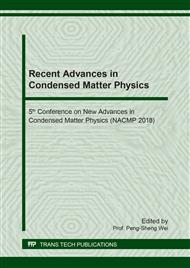p.61
p.69
p.75
p.81
p.87
p.93
p.99
p.105
p.113
Extinction Capability of Carbon Nanofibers to Millimeter Wave
Abstract:
Carbon nanofibers, whose diameter is between carbon nanotubes and conventional carbon fibers, is a new type of nanomaterials with features of good absorbing performance, small size and low density, and is easy to meet the requirements of passive interference materials.To study the interference properties of carbon nanofibers to millimeter wave, the interaction model of carbon nanofibers and electromagnetic field is established in this paper. The integral equation of the carbon nanofibers inductive current is established and solved by using of the method of moment, and the formula of mass extinction coefficient is obtained. The relationships between the mass extinction coefficient of carbon nanofibers and the millimeter wavelength, the diameter and length of fibers are analyzed via programming by Matlab. It is revealed that the extinction capability of carbon nanofibers decreases as the wavelength of millimeter wave increases. The larger the ratio of length to diameter of carbon nanofibers, the better its extinction capability to millimeter wave will be.
Info:
Periodical:
Pages:
87-92
Citation:
Online since:
November 2018
Authors:
Price:
Сopyright:
© 2018 Trans Tech Publications Ltd. All Rights Reserved
Share:
Citation:


